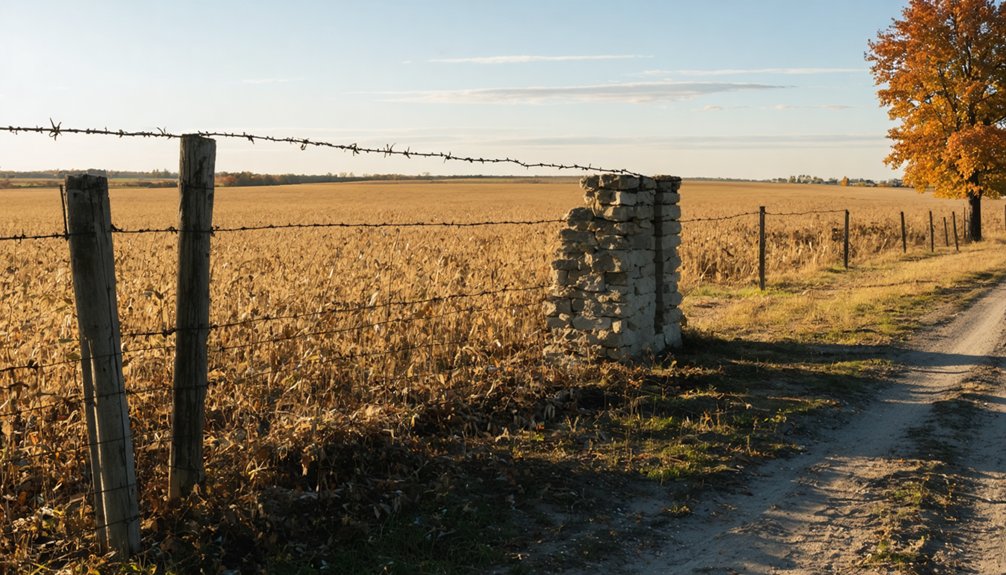You’ll find the abandoned ghost town of Lexington situated 2.5 miles southeast of Bone Gap in Edwards County, Illinois. Early pioneers from Kentucky and Tennessee established this frontier settlement in the early 19th century, building log homes and relying on hunting, farming, and Ransom Iggins’ water mill. Geographic isolation and economic pressures led to its decline by the mid-1800s as residents moved to more prosperous areas like Albion. While no visible traces remain today, its legacy lives on through local historical records and archaeological interests.
Key Takeaways
- Lexington was a 19th-century settlement located 2.5 miles southeast of Bone Gap in Edwards County, Illinois.
- The town declined due to geographic isolation, economic pressures, and competition from the growing town of Albion.
- Early settlers from Kentucky and Tennessee established a community focused on farming, hunting, and basic trades.
- No visible remains of Lexington exist today, as the former town site has been converted to agricultural land.
- Local historical societies maintain documentation of the ghost town, though no historical markers or preservation efforts exist.
Historical Settlement and Geographic Location
As pioneers pushed westward in the early 19th century, Lexington emerged as a settlement in Edwards County, Illinois, approximately 2.5 miles southeast of what would become Bone Gap.
You’ll find this ghost town‘s geographic coordinates at roughly 38°24′57″N latitude and 87°57′51″W longitude.
Early pioneers, including the Daston brothers around 1800, established settlement patterns that shaped the region’s development.
Pioneer families like the Dastons shaped this frontier region’s future through their early settlement choices and community-building efforts.
Most settlers came from Kentucky and Tennessee, creating a network of small villages and farming communities across Edwards County’s prairie landscape.
The area’s natural resources, including timber and water access, influenced where people chose to build.
Safety concerns, such as potential Indian raids, also played an essential role in determining settlement locations and community development within the southeastern Illinois frontier.
Like many places named Lexington in America, this settlement carried historical significance for early settlers who sought to honor their heritage.
Life in Early Lexington
When early pioneers first settled in Lexington during the 1820s, they faced the harsh realities of frontier life with remarkable resilience.
These settlers relied heavily on survival strategies like hunting, fishing, and subsistence farming to sustain their families. You’d find community gatherings centered around practical needs, such as grinding grain at Ransom Iggins’ water mill or sharing labor for cabin construction.
- Built basic log homes using local materials, with daily routines focused on tending crops and livestock
- Created self-sufficient homesteads through hunting, fishing, and growing corn
- Made their own clothing from animal hides and woven fabrics
- Formed strong social bonds through shared labor and mutual aid networks
Without formal schools or churches, settlers maintained informal educational and religious activities while adapting to their isolated frontier existence.
The Decline and Abandonment
Despite its early promise as a frontier settlement, Lexington’s decline began through a combination of geographic isolation and mounting economic pressures during the mid-19th century.
Similar to Wanboro’s fate, Lexington struggled after competition from the growing town of Albion drew away residents and commerce.
You’ll find that several economic factors contributed to its downfall, including limited access to markets and lack of railroad connections that were essential for trade during that era.
The town also faced devastating health crises that plagued Edwards County, similar to those that forced the abandonment of nearby Palmyra in 1821.
Without major industries or infrastructure to sustain growth, Lexington’s population gradually dwindled as residents sought opportunities in more prosperous communities like Albion and Bone Gap.
As with many other abandoned communities in Illinois, the land where Lexington once stood has been transformed into fertile farmland.
The settlement’s final abandonment occurred without fanfare, and today, you’ll find no trace of the former community on modern maps.
Current Status and Physical Remains
Today, you’ll find no visible traces of the once-established settlement of Lexington, which lies 2.5 miles southeast of Bone Gap in rural Edwards County, Illinois.
This ghost town has become part of the agricultural landscape, with its former streets and buildings giving way to farmland. Like many Illinois towns facing population decline, such as Cairo which dropped to under 2,000 residents, Lexington gradually faded into history. Many small towns in Illinois have seen dramatic changes, with places like Pearl dropping from 928 residents in 1890 to just over 100 today. The site holds archaeological interest for those studying Illinois’ rural settlements, though no formal preservation efforts are currently underway.
- You can access the location by road, though you won’t find any marked historical markers.
- The surrounding area features typical Illinois rolling hills and farmland.
- Local historical societies maintain some documentation of the former settlement.
- The land is now primarily used for agricultural purposes, blending seamlessly with neighboring farms.
Local Impact and Historical Legacy
Although Lexington no longer exists as a physical settlement, its historical legacy deeply influenced Edwards County’s early development in the 19th century. The town demonstrated remarkable community resilience through its pioneering settlers, who established agricultural ventures and frontier trades that contributed to the local economy.
Early pioneers of Lexington shaped Edwards County through their resilient spirit and economic contributions, despite the settlement’s eventual disappearance.
You’ll find that Lexington’s impact extended beyond its brief existence, as it helped shape early infrastructure and transportation routes that connected neighboring settlements.
The town’s eventual abandonment triggered significant migration patterns within Edwards County, as residents relocated to more prosperous areas.
While Lexington’s physical structures have vanished, its cultural legacy lives on through oral histories and genealogical records that document the determination of English and other immigrant settlers who carved out lives on the Illinois frontier.
Frequently Asked Questions
Were There Any Natural Disasters That Contributed to Lexington’s Abandonment?
You won’t find records of tornado impact or flood damage destroying Lexington. Despite the region’s challenging environment, no specific natural disasters directly caused this settlement’s abandonment – it faded gradually over time.
Did Any Famous Pioneers or Historical Figures Visit Lexington?
You won’t find records of famous pioneer visits to Lexington, though nearby settlers like Judge Mayo and the Daston brothers shaped the region’s historical significance in Edwards County’s early development.
What Crops or Livestock Were Primarily Raised by Lexington’s Settlers?
You’d find settlers focusing on corn cultivation as their primary crop, while managing diverse livestock including cattle, horses, and hogs. They also grew wheat, oats, and hay for sustenance.
Were There Any Native American Settlements Near Lexington Before Colonization?
While you’ll find evidence of Native tribes in Edwards County, there aren’t specific documented settlements at Lexington’s exact location. The Illinois Confederation and Piankeshaw people moved through this region before colonization.
Did Lexington Have Connections to the Underground Railroad During the 1800S?
You won’t find documented evidence of Underground Railroad connections in Lexington, though central Illinois had significant activity. Historical significance of nearby towns like Bloomington suggests possible undocumented involvement in freedom routes.
References
- https://www.youtube.com/watch?v=93k0qtvzkn4&vl=en-US
- https://libsysdigi.library.illinois.edu/oca/Books2008-05/historyofenglish00flow/historyofenglish00flow.pdf
- http://livinghistoryofillinois.com/pdf_files/History-of-Edwards-Lawrence-and-Wabash-counties-Illinois-1883.pdf
- https://digitalarchives.aum.edu/sites/default/files/2024-12/Woodham_EdwardsCountyIL.pdf
- https://en.wikipedia.org/wiki/Lexington
- https://www.familysearch.org/en/wiki/Edwards_County
- https://drloihjournal.blogspot.com/2022/09/lost-towns-of-illinois-lexington.html
- http://genealogytrails.com/ill/edwards/history_firstsettlers.html
- https://en.wikipedia.org/wiki/List_of_ghost_towns_in_Illinois
- https://archive.org/download/combinedhistoryo00phil/combinedhistoryo00phil.pdf



